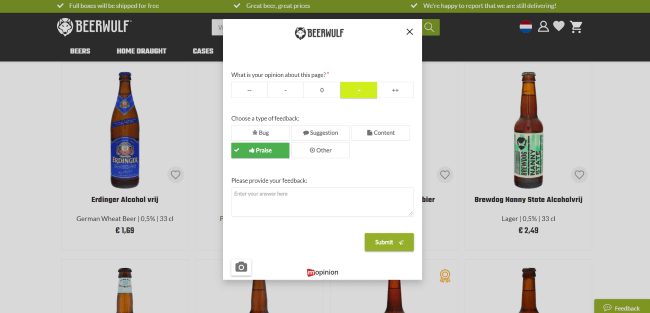CRO is the practice of increasing the percentage of users who perform a desired action on a website, whether that’s purchasing, signing up for a service, or even something so simple as filling out a form. However, somewhere along the line this process has really become a balancing act. In fact, most CRO specialists are up to their necks in a massive ecosystem of digital tools that aid in everything from website analysis and mouse tracking to technical analysis and user testing.
And the fact of the matter is, many of these specialists are actually missing out on an important factor. Measuring CRO is often viewed as a numbers game. But there’s a whole other side to CRO that involves leveraging more soft (humanized), qualitative data; data which gives light to insights such as consumer intent and behaviour.
How do your users feel? Why are they behaving in a certain way? Why are they dropping off in certain online funnels? To fully understand the numbers, you’re going to need qualitative data to complement it.
Qualitative data is just as important as quantitative data. It gives voice to your impact and allows you to align your goals with the needs of those you serve.
To get some input on how this is done in practice, Mopinion interviewed a CRO specialist who is very much familiar with setting up CRO experiments and monitoring them with the help of qualitative data.
Meet Tim Thijsse from Beerwulf. With seven years of experience as a web consultant in both insurance and publishing, a background in user experience and of course, an in-depth understanding of CRO thanks to his work on many projects such as Vandervalk.nl and Ziggo, Tim is currently a CRO specialist at Beerwulf, a fast-growing online craft beer shop. He works closely with product designers and journey expert researchers to gather insights into the behaviour of users on the Beerwulf website.
Note: this interview has been transcribed from Mopinion’s 360 Digital podcast series. Prefer to listen to the podcast interview?

Listen to this episode now on any of these channels:
The Challenges of a CRO Specialist
“As a CRO specialist, there are two big challenges. One is giving structure to your optimisation efforts. Our team must prioritise ideas and experiments based on potential and proof that the experiment will have substantial impact, but we also need to consider the strategy and mission of the company itself. That being said, it’s very important to maintain contact with stakeholders and ensure all ideas and experiments effectively optimise the website and are in line with the overall strategy.”
“The second challenge is bringing the right teams together. Most companies have great tools and plenty of data, but lack solid communication between teams. For example, a lot of times you’ll see online specialists splitting up into separate teams, i.e. acquisition and retention. These teams both focus on the same user, but perform separate user research. And unfortunately, this manner of doing things creates a lot of obscurity.”
So how does one overcome these challenges? And which tools are put in place to manage these activities?
“The only way to overcome those challenges is to think about the journeys within your own company. For example, think about which topics within your team are also relevant for other teams. And take a closer look at which channels you use within the company to raise awareness of certain topics.”
In other words, it’s all about knowledge sharing and bringing teams together for a common goal.
And what about the tools used?
“At Beerwulf, we have different kinds of tools that we use. For instance we use Mopinion for qualitative customer insights, ContentSquare to track onsite user behaviour and Airtable Interface to make the insights available to the entire company. This is essentially input for new experiments.”
“Quantitative data will soon mostly be automated, saving analysts time otherwise spent on manually analysing results and pinpointing pain points in the user journey. As a result, more time can be allocated towards improving the humanised part of optimisation. In other words, focusing on the soft data and building a more complete user overview based on psychology, qualitative user input and screen recordings.

Combining quantitative and qualitative data
Tim equates monitoring quantitative and qualitative data to a two-way street.
“At Beerwulf we use the soft data to prioritise which hard data is most important. It helps us recognise which metrics need to be measured, but also in reverse. The soft data helps us understand our users and how they think. Then we take that knowledge and apply it to our quantitative research efforts.”
An example Tim uses is checkout abandonment. Almost every ecommerce organisation has been confronted with this problem. The customer adds an item to the cart and then never completes the checkout process. Fortunately the soft data you collect (i.e. user feedback) at this moment will give you an indication of why they have abandoned the checkout, thus giving you a better indication of what the underlying reason for the drop-offs is.
“Soft data transforms conversion optimisation from just fixing a problem that’s in the funnel or performance issue based on your user data to understanding the user and optimising the overall user experience.”
Feedback gives perspective
As a result of feedback, my former colleague Lars Harmsen and our UX team at Beerwulf made a number of changes to the website.
We changed filters, altered content, and even updated the checkout based on input from our customers and tools that enable screen recording.
Additionally they leveraged soft data in a variety of other ways to gain insight into customer desires:
- They held usability sessions where they identified that users had a different way of searching for products. The learned that instead of searching based on tastes, they wanted to find drinks based on the style of the beer, i.e. IPA, Triple, etc.
- They adjusted content based on user feedback input, having learned that one of the biggest USPs of their home taps was portability and taking the taps to parties. This proved really useful in marketing the product.
- They can now cater better to other countries. For example, Belgium zipcodes are in a different format so a lot of their Belgian users couldn’t complete checkout due to restrictions, which resulted in a drop off in the checkout of 50%.
“As you can see, soft data is really necessary to our CRO strategy and it is a great supplement to our hard data. Bringing this data together with other teams and creating a sense of involvement and awareness, however, is what helps us achieve a shared understanding of the user and achieve our goals as a company.”
Ready to see Mopinion in action?
Want to learn more about Mopinion’s all-in-1 user feedback platform? Don’t be shy and take our software for a spin! Do you prefer it a bit more personal? Just book a demo. One of our feedback pro’s will guide you through the software and answer any questions you may have.










